Spatio-Temporal Variations and Influencing Factors of Country-Level Carbon Emissions for Northeast China Based on VIIRS Nighttime Lighting Data
Abstract
1. Introduction
2. Data Sources
2.1. Nighttime Lighting Data Source and Processing
2.2. Nighttime Lighting Data Calculation
2.3. Energy Statistics Sources
3. Research Methodology
3.1. Calculation of Carbon Emissions from Energy Consumption
3.2. Carbon Emission Estimation Model Hypothesis
3.3. Index Selection
3.4. Geographic Detector
3.4.1. Divergence and Factor Detection
3.4.2. Interaction Detection
4. Results
4.1. Carbon Emission Estimation Model and Accuracy Check
4.1.1. Carbon Emission Estimation Model
4.1.2. Accuracy Check
4.2. General Characteristics of County Carbon Emissions in Northeast China
4.3. Trends in Carbon Emissions by Region
4.4. Trends in Carbon Emissions of Counties and Cities in Northeast China
4.5. Analysis of Influencing Factors
4.5.1. Detection of Single Factor
4.5.2. Detection Interactions
5. Policy Recommendations
6. Conclusions
- (1)
- The accuracy of the county-level carbon emission inversion model in Northeast China is relatively high. The determination coefficient R2 of the regression equation is 0.7722. It indicates that there is a high correlation between carbon dioxide and nighttime light data. The proportional coefficient is 0.1217. More than 80% of the provinces have an error of less than 25%, meeting the estimation accuracy requirements. It indicates that nighttime lighting can explain the carbon emission data of counties in Northeast China.
- (2)
- From 2012 to 2020, carbon emissions in county towns in Northeast China showed a trend of rising before falling, increasing from 461.159 million tons in 2012 to 486.325 million tons in 2014 and slowly falling to 405.752 million tons in 2020. Per capita carbon emissions show the same trend, increasing from 9.01 tons per capita in 2012 to 9.72 tons per capita in 2014. It then decreased to 7.91 tons per capita in 2020. In conclusion, the carbon emissions in the counties of Northeast China showed a convergence trend and reached a peak in 2014.
- (3)
- High growth areas of carbon emissions are concentrated in provincial capitals and first-tier cities. The counties with medium-high growth rate are mainly distributed in the northern and coastal areas of Northeast China. These areas are characterized by concentrated distribution around provincial capitals. The counties and towns with medium-low and low growth rates are mainly distributed in the underdeveloped areas in the north and south in Northeast China.
- (4)
- This analysis analyzes the degree of single and interactive influences of economic level, population size, urbanization rate, industrial structure, and public finance revenue and expenditure on carbon emissions in the counties of Northeast China using the geographic detector method. The results show that, under the single influence factor, the most influential factor on county carbon emissions in 2012 was the value added of secondary production. The most influential factor in 2016 and 2020 was the urbanization rate. Under the two-factor interaction, it is found by comparison that other factors showed a higher level of influence on county carbon emissions when interacting with the urbanization rate.
Author Contributions
Funding
Institutional Review Board Statement
Informed Consent Statement
Data Availability Statement
Conflicts of Interest
References
- Bronselaer, B.; Zanna, L. Heat and carbon coupling reveals ocean warming due to circulation changes. Nature 2020, 584, 227–233. [Google Scholar] [CrossRef] [PubMed]
- den Elzen, M.; Fekete, H.; Hohne, N.; Admiraal, A.; Forsell, N.; Hof, A.F.; Olivier, J.G.J.; Roelfsema, M.; van Soest, H. Greenhouse gas emissions from current and enhanced policies of China until 2030: Can emissions peak before 2030? Energy Policy 2016, 89, 224–236. [Google Scholar] [CrossRef]
- Long, Y.; Gao, S. Shrinking cities in China: The overall profile and paradox in planning. In Shrinking Cities in China; Springer: Singapore, 2019; pp. 3–21. [Google Scholar]
- Tong, Y.; Liu, W.; Li, C.; Zhang, J.; Ma, Z. Understanding patterns and multilevel influencing factors of small-town shrinkage in Northeast China. Sustain. Cities Soc. 2021, 68, 102811. [Google Scholar] [CrossRef]
- Li, W.; Li, H.; Wang, S.; Feng, Z. Spatiotemporal Evolution of County-Level Land Use Structure in the Context of Urban Shrinkage: Evidence from Northeast China. Land 2022, 11, 1709. [Google Scholar] [CrossRef]
- Meng, L.; Graus, W.; Worrell, E.; Huang, B. Estimating CO2 (carbon dioxide) emissions at urban scales by DMSP/OLS (Defense Meteorological Satellite Program’s Operational Linescan System) nighttime light imagery: Methodological challenges and a case study for China. Energy 2014, 71, 468–478. [Google Scholar] [CrossRef]
- Shi, K.; Chen, Y.; Yu, B.; Xu, T.; Yang, C.; Li, L.; Huang, C.; Chen, Z.; Liu, R.; Wu, J. Detecting spatiotemporal dynamics of global electric power consumption using DMSP-OLS nighttime stable light data. Appl. Energy 2016, 184, 450–463. [Google Scholar] [CrossRef]
- Elvidge, C.D.; Baugh, K.; Zhizhin, M.; Hsu, F.C.; Ghosh, T. VIIRS night-time lights. Int. J. Remote Sens. 2017, 38, 5860–5879. [Google Scholar] [CrossRef]
- John, R.; Chen, D. Remote sensing technology for mapping and monitoring land-cover and land-use change. Prog. Plan. 2004, 61, 301–325. [Google Scholar]
- Rosenqvist, Å.; Milne, A.; Lucas, R.; Imhoff, M.; Dobson, C. A review of remote sensing technology in support of the Kyoto Protocol. Environ. Sci. Policy 2003, 6, 441–455. [Google Scholar] [CrossRef]
- Justice, C.O.; Román, M.O.; Csiszar, I.; Vermote, E.F.; Wolfe, R.E.; Hook, S.J.; Friedl, M.; Wang, Z.; Schaaf, C.B.; Miura, T.; et al. Land and cryosphere products from Suomi NPP VIIRS: Overview and status. J. Geophys. Res. Atmos. 2013, 118, 9753–9765. [Google Scholar] [CrossRef]
- Li, X.; Xu, H.; Chen, X.; Li, C. Potential of NPP-VIIRS nighttime light imagery for modeling the regional economy of China. Remote Sens. 2013, 5, 3057–3081. [Google Scholar] [CrossRef]
- Elvidge, C.D.; Zhizhin, M.; Ghosh, T.; Hsu, F.C.; Taneja, J. Annual Time Series of Global VIIRS Nighttime Lights Derived from Monthly Averages: 2012 to 2019. Remote Sens. 2021, 13, 922. [Google Scholar] [CrossRef]
- Elvidge, C.D.; Baugh, K.E.; Kihn, E.A.; Kroeh, H.W.; Davis, E.W. Mapping city lights with nighttime data from the DMSP Operational Linescan System. Eng. Remote Sens. 1997, 63, 727–734. [Google Scholar]
- Xu, C.; Gertner, G.Z.; Scheller, R.M. Uncertainties in the response of a forest landscape to global climatic change. Glob. Chang. Biol. 2009, 15, 116–131. [Google Scholar] [CrossRef]
- Oda, T.; Maksyutov, S. A very high-resolution (1 km × l km) global fossil fuel CO2 emission inventory derived using a point source database and satellite observations of nighttime lights. Atmos. Chem. Phys. 2011, 11, 543–556. [Google Scholar] [CrossRef]
- Raupach, M.; Rayner, P.; Paget, M. Regional variations in spatial structure of nightlights, population density and fossil-fuel CO2 emissions. Energy Policy 2010, 38, 4756–4764. [Google Scholar] [CrossRef]
- Ghosh, T.; Elvidge, C.D.; Sutton, P.C.; Baugh, K.E.; Ziskin, D.; Tuttle, B.T. Creating a global grid of distributed fossil fuel CO2 emissions from nighttime satellite imagery. Energies 2010, 3, 1895–1913. [Google Scholar] [CrossRef]
- Wang, Y.; Li, G. Mapping urban CO2 emissions using DMSP/OLS’ city lights’ satellite data in China. Environ. Plan. A 2016, 49, 248–251. [Google Scholar] [CrossRef]
- Lu, H.; Liu, G. Spatial effects of carbon dioxide emissions from residential energy consumption:A county-level study using enhanced nocturnal lighting. Appl. Energy 2014, 131, 297–306. [Google Scholar] [CrossRef]
- Lenzen, M.; Schaeffer, R.; Karstensen, J.; Peters, G.P. Drivers of change in Brazil’s carbon dioxide emissions. Clim. Chang. 2013, 121, 815–824. [Google Scholar] [CrossRef]
- Lau, L.-S.; Choong, C.-K.; Eng, Y.-K. Investigation of the environmental Kuznets curve forcarbon emissions in Malaysia: Do foreign direct investment and trade matter? Energy Policy 2014, 68, 490–497. [Google Scholar] [CrossRef]
- Alam, M.J.; Begum, A.; Buysse, J.; Van Huylenbroeck, G. Energy consumption, carbon emissions and economic growth nexus in Bangladesh: Cointegration and dynamic causality analysis. Energy Policy 2012, 45, 217–225. [Google Scholar] [CrossRef]
- Lee, J.W.; Brahmasrene, T. Investigating the influence of tourism on economic growth and carbon emissions: Evidence from panel analysis of the European Union. Tour. Manag. 2013, 38, 69–76. [Google Scholar] [CrossRef]
- Mahony, T.O. Decomposition of Ireland’s carbon emissions from 1990 to 2010: An extended Kaya identity. Energy Policy 2013, 59, 573–581. [Google Scholar] [CrossRef]
- Wang, Y.; Li, L.; Kubota, J.; Han, R.; Zhu, X.; Lu, G. Does urbanization lead to more carbon emission? Evidence from a panel of BRICS countries. Appl. Energy 2016, 168, 375–380. [Google Scholar] [CrossRef]
- Li, H.; Mu, H.; Zhang, M.; Gui, S. Analysis of regional difference on impact factors of China’s energy-Related CO2 emissions. Energy 2012, 39, 319–326. [Google Scholar] [CrossRef]
- Ning, Z.; Wang, B.; Chen, Z. Carbon emissions reductions and technology gaps in the world’s factory, 1990–2012. Energy Policy 2016, 91, 28–37. [Google Scholar]
- Zhao, L.-X.; Zhang, L.-H.; Song, X.-W.; Qin, N.-J.; Zhang, J. Carbon Emission of Guangxi’s Major Industries and Measures for Low-carbon Economic Development. In Low-Carbon City and New-Type Urbanization; Springer: Berlin/Heidelberg, Germany, 2015; pp. 163–175. [Google Scholar]
- Xu, X.; Tan, Y.; Chen, S.; Yang, G.; Su, W. Urban household carbon emission and contributing factors in the Yangtze River Delta, China. PloS ONE 2015, 10, e0121604. [Google Scholar] [CrossRef]
- Wang, P.; Wu, W.; Zhu, B.; Wei, Y. Examining the impact factors of energy-related CO2 emissions using the STIRPAT model in Guangdong Province, China. Appl. Energy 2013, 106, 65–71. [Google Scholar] [CrossRef]
- Fang, C.; Wang, S.; Li, G. Changing urban forms and carbon dioxide emissions in China: A case study of 30 provincial capital cities. Appl. Energy 2015, 158, 519–531. [Google Scholar] [CrossRef]
- Permana, A.S.; Perera, R.; Kumar, S. Understanding energy consumption pattern of households in different urban development forms: A comparative study in Bandung City, Indonesia. Energy Policy 2008, 36, 4287–4297. [Google Scholar] [CrossRef]
- Ou, J.; Liu, X.; Li, X.; Chen, Y. Quantifying the relationship between urban forms and carbon emissions using panel data analysis. Landsc. Ecol. 2013, 28, 1889–1907. [Google Scholar] [CrossRef]
- Yan, K.; Park, T.; Chen, C.; Xu, B.; Xu, B.; Song, W.; Yang, B.; Zeng, Y.; Liu, Z.; Yan, G.; et al. Generating global products of LAI and FPAR from SNPP-VIIRS data: Theoretical background and implementation. IEEE Trans. Geosci. Remote Sens. 2018, 56, 2119–2137. [Google Scholar] [CrossRef]
- Liang, C.; Liu, Z.; Geng, Z. Assessing e-commerce impacts on China’s CO2 emissions: Testing the CKC hypothesis. Environ. Sci. Pollut. Res. 2021, 28, 56966–56983. [Google Scholar] [CrossRef]
- Shi, K.; Chen, Y.; Yu, B.; Xu, T.; Chen, Z.; Liu, R.; Li, L.; Wu, J. Modeling spatiotemporal CO2 (carbon dioxide) emission dynamics in China from DMSP-OLS nighttime stable light data using panel data analysis. Appl. Energy 2016, 168, 523–533. [Google Scholar] [CrossRef]
- Liu, S.; Shen, J.; Liu, G.; Wu, Y.; Shi, K. Exploring the effect of urban spatial development pattern on carbon dioxide emissions in China: A socioeconomic density distribution approach based on remotely sensed nighttime light data. Comput. Environ. Urban Syst. 2022, 96, 101847. [Google Scholar] [CrossRef]
- Zhang, X.; Wu, J.; Peng, J.; Cao, Q. The uncertainty of nighttime light data in estimating carbon dioxide emissions in China: A comparison between DMSP-OLS and NPP-VIIRS. Remote Sens. 2017, 9, 797. [Google Scholar] [CrossRef]
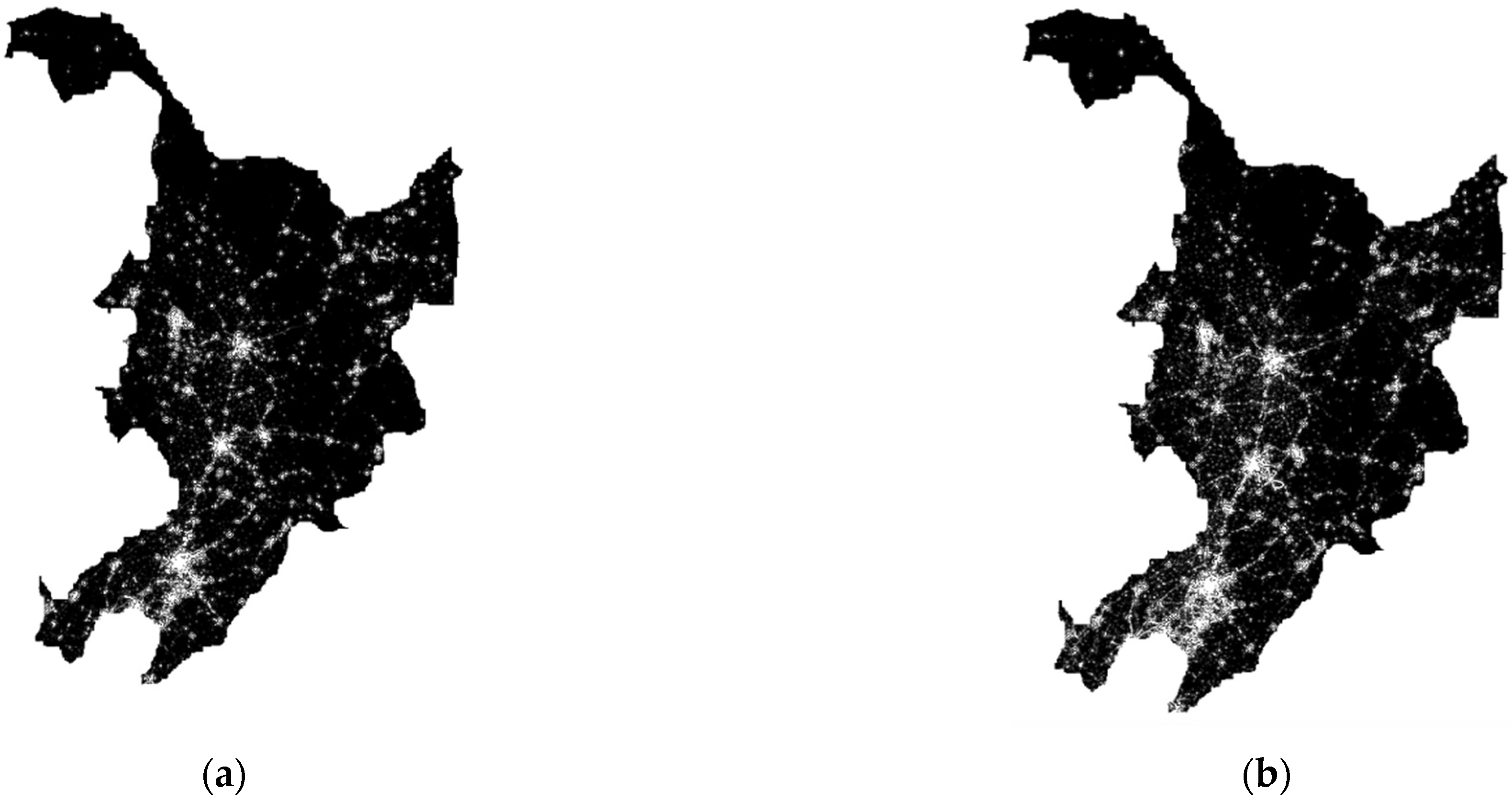
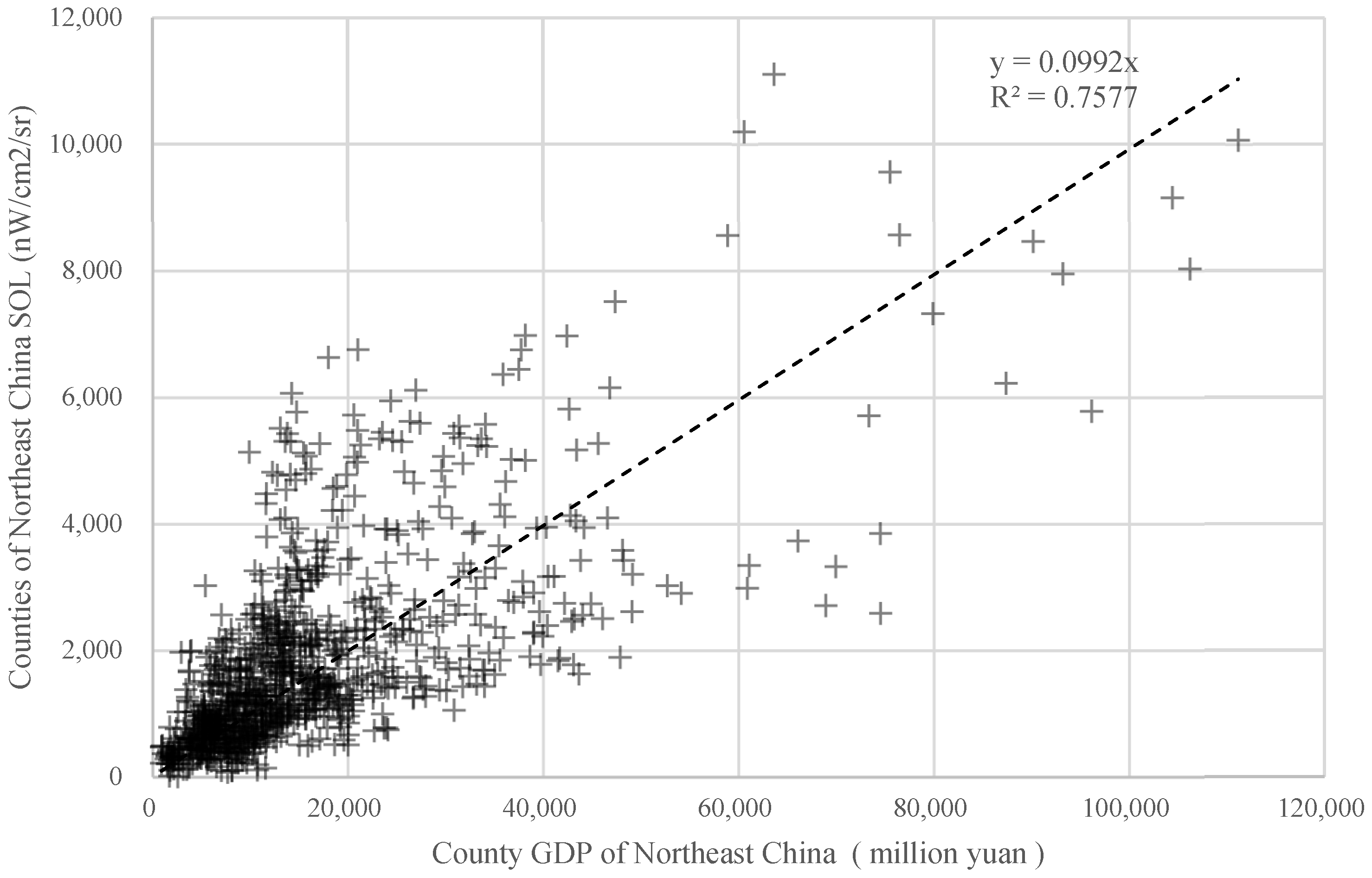
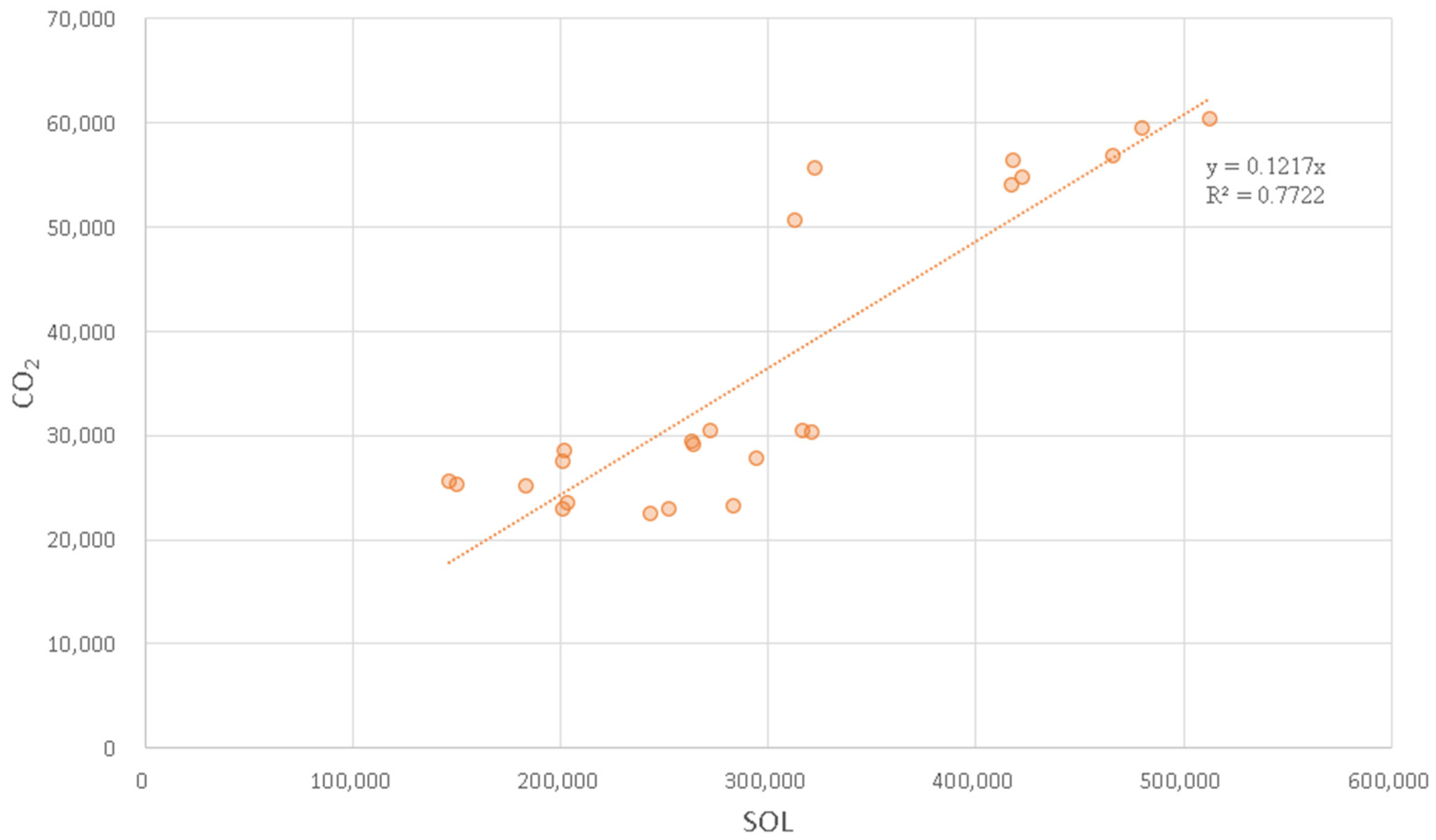

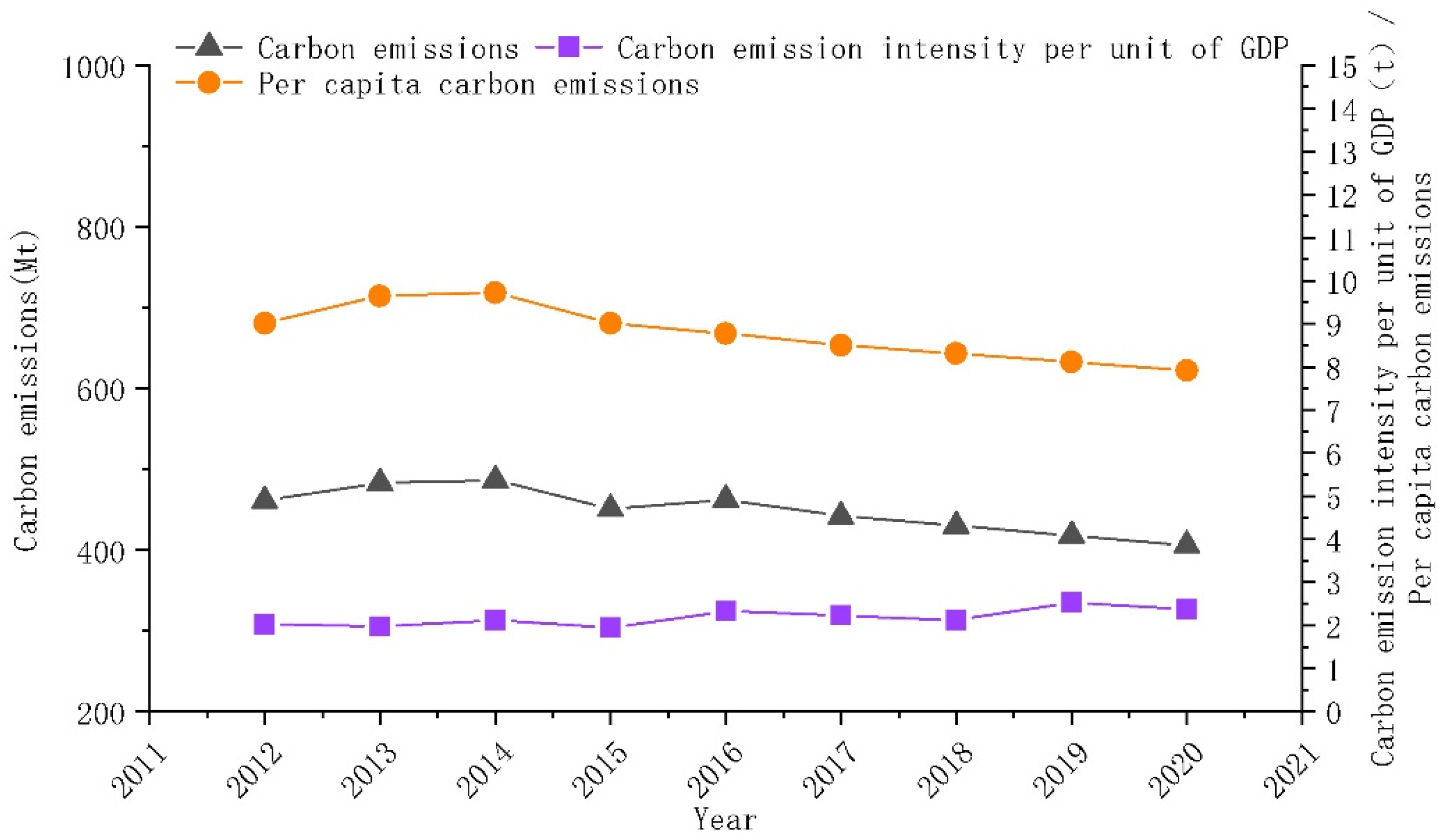

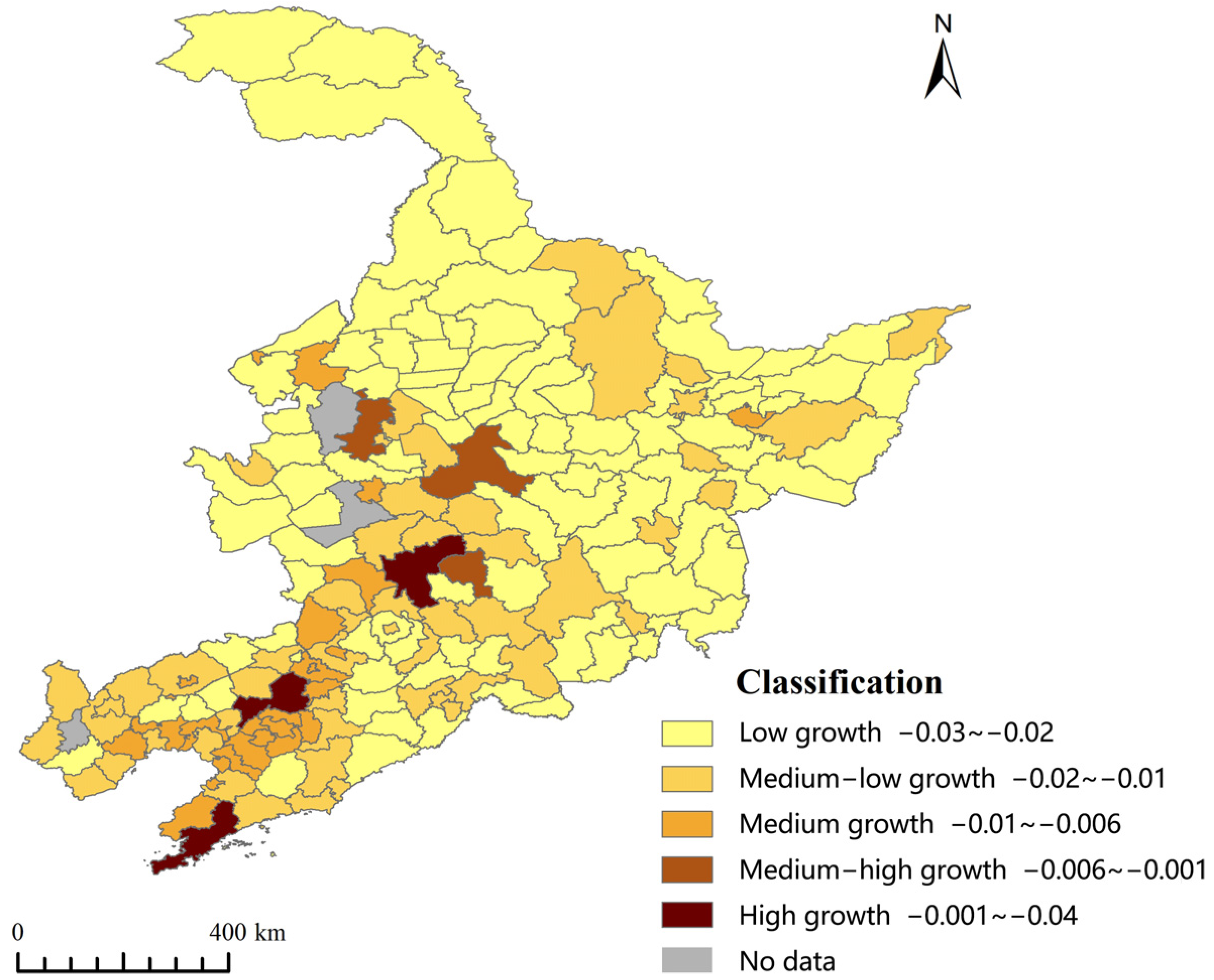
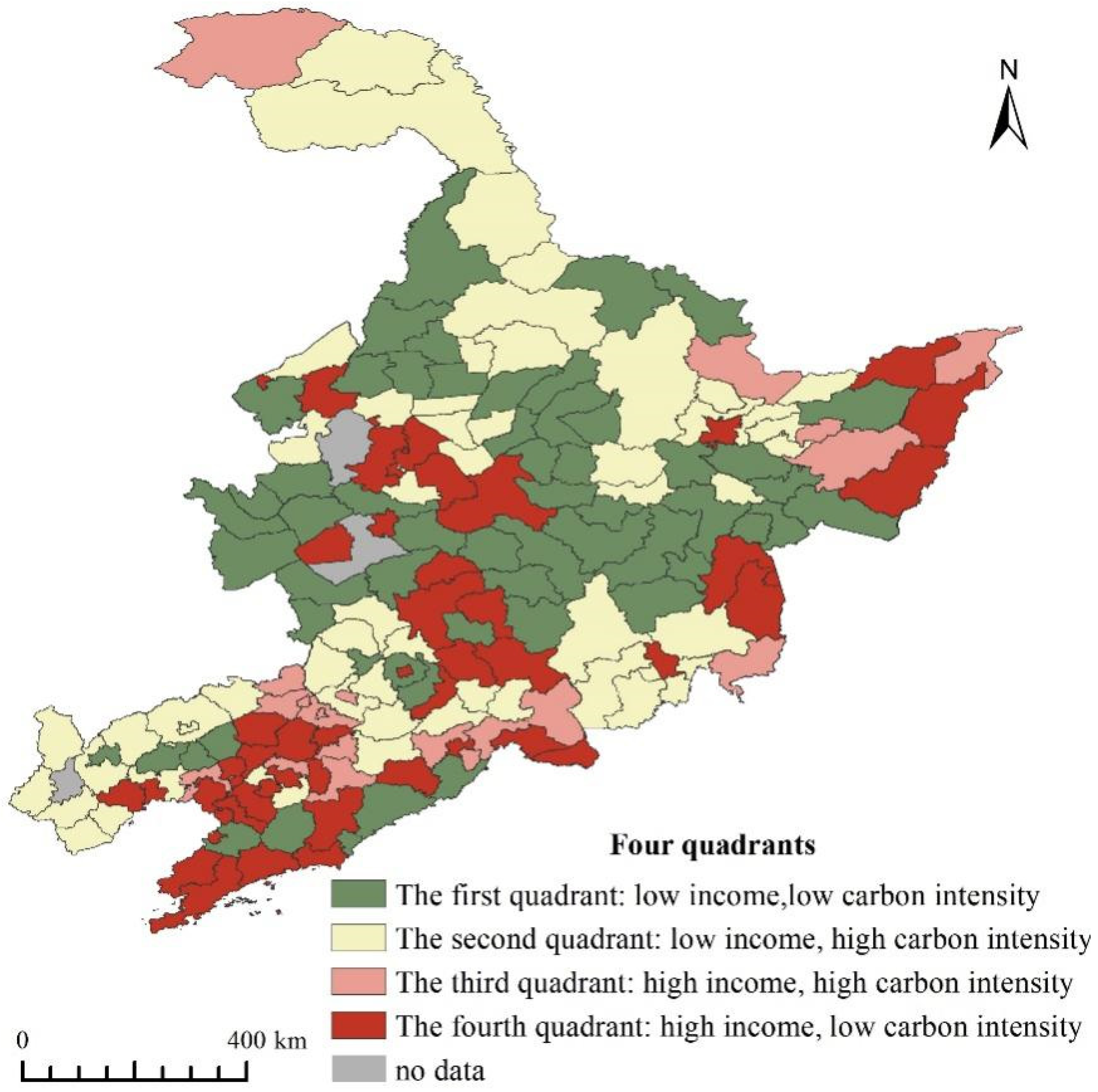
| Energy Name | Coal Coke | Coke | Coke Oven Gas | Blast Furnace Gas | Converter Gas | Other Gas | Crude Oil |
|---|---|---|---|---|---|---|---|
| NCV (kj/kg) | 20,908 | 28,435 | 17,981 | 3855 | 8585 | 18,273.6 | 41,816 |
| CEF (kg/TJ) | 95,977 | 105,996 | 44,367 | 259,600 | 181,867 | 44,367 | 73,333 |
| Energy Name | Gasoline | Kerosene | Diesel | Fuel Oil | Liquefied Petroleum Gas | Natural Gas | Liquefied Natural Gas |
| NCV (kj/kg) | 43,070 | 43,070 | 42,652 | 41,816 | 50,179 | 38,931 | 44,200 |
| CEF (kg/TJ) | 70,033 | 71,500 | 74,067 | 77,367 | 63,067 | 56,100 | 64,167 |
| Variable Type | Variable Name | Variable Meaning |
|---|---|---|
| Population | POP | Total population at the end of the year (10,000 people) |
| GDP per capita | GDPP | Per capita GDP (CNY) |
| Industrial structure | SE | Secondary industry added value |
| SP | Secondary industry added value/GDP | |
| Financial revenue and expenditure | INC | Local fiscal revenue (CNY 10,000) |
| EX | Local fiscal expenditure (CNY 10,000) | |
| Urbanization rate | UR | County resident population/total population |
| Region | 2012 | 2013 | 2014 | 2015 | 2016 | 2017 | 2018 | 2019 | 2020 |
|---|---|---|---|---|---|---|---|---|---|
| Liaoning Province | 25% | 29% | 10% | 6% | 6% | 1% | 2% | 3% | 4% |
| Jilin Province | 30% | 28% | 11% | 5% | 7% | 24% | 22% | 19% | 21% |
| Heilongjiang Province | 14% | 11% | 11% | 9% | 9% | 23% | 25% | 22% | 23% |
| Northeast China | 23% | 24% | 5% | 1% | 1% | 14% | 13% | 20% | 21% |
| Carbon Emissions (Million Tons) | Carbon Emissions Per Capita (Ton/Per Capita) | Carbon Emission Intensity (Ton/Per CNY Ten Thousand) | |||||||
|---|---|---|---|---|---|---|---|---|---|
| Heilongjiang | Jilin | Liaoning | Heilongjiang | Jilin | Liaoning | Heilongjiang | Jilin | Liaoning | |
| 2012 | 112.750 | 131.543 | 216.867 | 7.393 | 8.650 | 11.002 | 1.872 | 2.087 | 2.110 |
| 2013 | 142.141 | 128.372 | 212.410 | 9.489 | 8.505 | 10.945 | 2.112 | 1.878 | 1.936 |
| 2014 | 143.099 | 130.219 | 213.008 | 9.564 | 8.675 | 10.930 | 2.154 | 1.954 | 2.240 |
| 2015 | 136.146 | 118.016 | 196.805 | 9.059 | 7.877 | 10.110 | 1.972 | 1.688 | 2.166 |
| 2016 | 141.537 | 120.532 | 200.112 | 7.734 | 8.190 | 10.398 | 2.046 | 1.836 | 3.096 |
| 2017 | 121.766 | 123.023 | 197.322 | 6.729 | 8.526 | 10.246 | 1.760 | 1.874 | 3.053 |
| 2018 | 120.985 | 118.180 | 190.874 | 6.745 | 8.254 | 9.928 | 1.757 | 1.865 | 2.732 |
| 2019 | 115.124 | 116.273 | 186.499 | 6.458 | 8.187 | 9.709 | 2.009 | 2.725 | 2.866 |
| 2020 | 109.263 | 114.366 | 182.123 | 6.175 | 8.065 | 9.496 | 1.828 | 2.547 | 2.719 |
| Index | q | ||
|---|---|---|---|
| 2012 | 2016 | 2020 | |
| POP | 0.421 *** | 0.410 *** | 0.409 *** |
| GDPP | 0.153 *** | 0.305 *** | 0.030 |
| SE | 0.568 *** | 0.259 *** | 0.494 *** |
| SP | 0.220 *** | 0.10 | 0.195 *** |
| INC | 0.560 *** | 0.374 *** | 0.551 *** |
| EX | 0.548 *** | 0.288 *** | 0.260 *** |
| UR | 0.413 *** | 0.714 *** | 0.648 *** |
| Interacting Factors | 2012 | Interacting Factors | 2016 | Interacting Factors | 2020 |
|---|---|---|---|---|---|
| UR ∩ INC | 0.870 | UR ∩ GDPP | 0.812 | UR ∩ INC | 0.799 |
| UR ∩ SE | 0.789 | UR ∩ EX | 0.804 | UR ∩ SE | 0.796 |
| UR ∩ SP | 0.773 | UR ∩ INC | 0.803 | UR ∩ GDPP | 0.796 |
| POP ∩ INC | 0.760 | UR ∩ SP | 0.782 | UR ∩ SP | 0.792 |
| POP ∩ GDPP | 0.733 | UR ∩ SE | 0.775 | UR ∩ EX | 0.788 |
| POP ∩ SE | 0.723 | POP ∩ UR | 0.761 | POP ∩ SE | 0.735 |
| UR ∩ EX | 0.710 | GDPP ∩ SE | 0.711 | UR ∩ POP | 0.720 |
| POP ∩ SP | 0.701 | INC ∩ GDPP | 0.710 | POP ∩ INC | 0.708 |
| EX ∩ INC | 0.696 | EX ∩ GDPP | 0.703 | POP ∩ SP | 0.687 |
| SE ∩ EX | 0.692 | POP ∩ GDPP | 0.690 | POP ∩ GDPP | 0.666 |
Disclaimer/Publisher’s Note: The statements, opinions and data contained in all publications are solely those of the individual author(s) and contributor(s) and not of MDPI and/or the editor(s). MDPI and/or the editor(s) disclaim responsibility for any injury to people or property resulting from any ideas, methods, instructions or products referred to in the content. |
© 2023 by the authors. Licensee MDPI, Basel, Switzerland. This article is an open access article distributed under the terms and conditions of the Creative Commons Attribution (CC BY) license (https://creativecommons.org/licenses/by/4.0/).
Share and Cite
Xu, G.; Zeng, T.; Jin, H.; Xu, C.; Zhang, Z. Spatio-Temporal Variations and Influencing Factors of Country-Level Carbon Emissions for Northeast China Based on VIIRS Nighttime Lighting Data. Int. J. Environ. Res. Public Health 2023, 20, 829. https://doi.org/10.3390/ijerph20010829
Xu G, Zeng T, Jin H, Xu C, Zhang Z. Spatio-Temporal Variations and Influencing Factors of Country-Level Carbon Emissions for Northeast China Based on VIIRS Nighttime Lighting Data. International Journal of Environmental Research and Public Health. 2023; 20(1):829. https://doi.org/10.3390/ijerph20010829
Chicago/Turabian StyleXu, Gang, Tianyi Zeng, Hong Jin, Cong Xu, and Ziqi Zhang. 2023. "Spatio-Temporal Variations and Influencing Factors of Country-Level Carbon Emissions for Northeast China Based on VIIRS Nighttime Lighting Data" International Journal of Environmental Research and Public Health 20, no. 1: 829. https://doi.org/10.3390/ijerph20010829
APA StyleXu, G., Zeng, T., Jin, H., Xu, C., & Zhang, Z. (2023). Spatio-Temporal Variations and Influencing Factors of Country-Level Carbon Emissions for Northeast China Based on VIIRS Nighttime Lighting Data. International Journal of Environmental Research and Public Health, 20(1), 829. https://doi.org/10.3390/ijerph20010829






